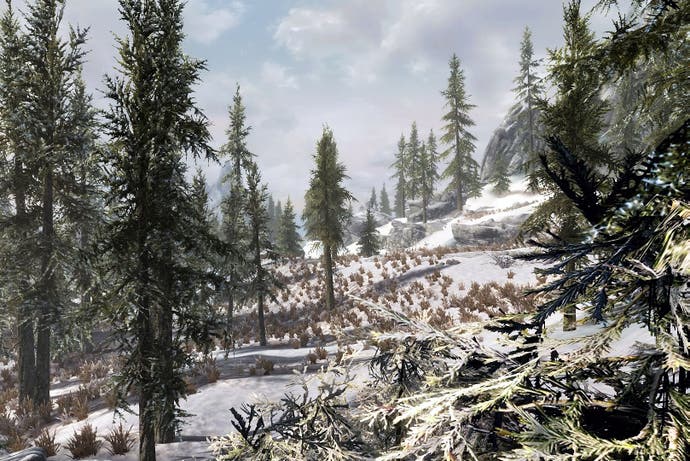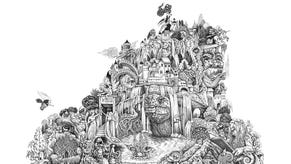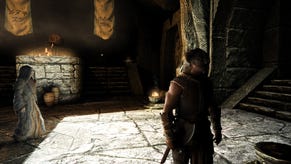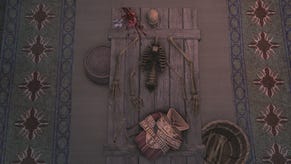Video games and the power of winter
Very cool.
Every season has its own distinct landscape look, feel and characteristics. This has permeated into game design incredibly pleasingly. It is easy to think of a video game setting bathed in the bright light of summer or covered by the golden palette of autumn. However, no season is perhaps as striking, atmospheric and powerful as winter. The winter landscape of games can be so perfectly represented and impactful that they appeal to our real-world attachment to them - the crunching of snow, leaving tracks and patterns, the eerie quiet, and the different dynamic frost and ice bring to a landscape, for example. Through design, the use of aesthetics and symbolism, by appealing to our senses and by containing features that affect and change the land, distinct and brilliant winter landscapes come to life. Deliberate design and the careful inclusion of many often-underrated elements of the landscape results in powerful vista compositions, effective and realistic winter plantings, and deep use of the architecture and scale of the land, that goes beyond the aesthetic. And, while the other seasons are more colourful and verdant, winter displays the bones of the landscape, where spatial composition and layout is exposed, and underlying design and features are revealed. By merging these with robust world narratives and environments rich with magic and majesty, we are gifted magical, wintry vignettes and transported to spectacular and powerful places.
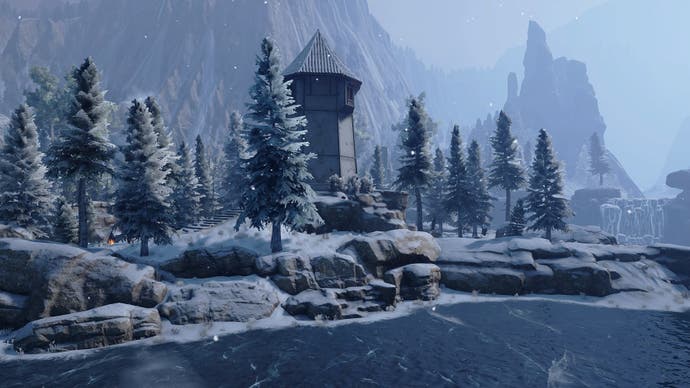
The impact of Skyrim's winter landscape hits twice in the early moments of the game. As the screen fades from black, the landscape shows us that the season is winter, encasing us in pine trees, winter mist, and snow, providing a glimpse of the landscape's aesthetic. After escaping the chaos of the introduction - evoking a similar sense of release at the beginning of Oblivion - we emerge from the caves and are greeted with a beautiful, expansive view of Skyrim. This is the moment that the landscape tells us, with no subtlety, that winter is not only the season but the whole setting. Winter is infused into the very land, featuring meaning, symbolism and design that transcends a wintry aesthetic. This is what plays a big part in our eventual feeling of total immersion, becoming as much a part of the landscape as the mountains, snow, plants, trees and forests.

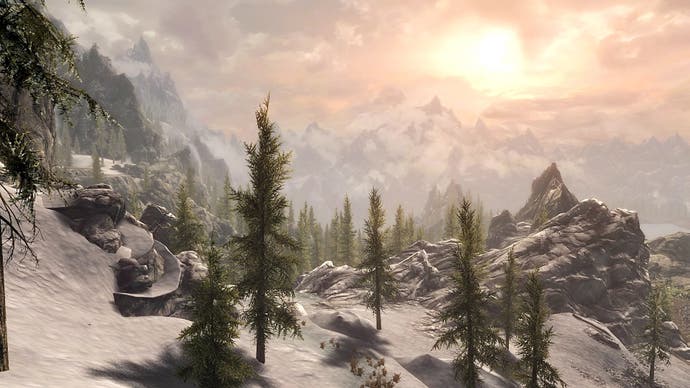
The forests and trees of Skyrim's landscape are a crucial and excellent winter element. From airy and welcoming, to dark and dense, the pine trees (particularly) and forests, reveal a lot about a landscape influenced by Nordic and Scandinavian culture, myths and tales. Crucial to Norse mythology, trees play a key role in the creation myth: Bor's sons (Odin, Vili and Vé) crafted a man called Ask (an Ash tree) and a woman called Embla (possibly 'elm' or 'vine') from tree logs, and from these descended the races of men. This importance was heightened due to the central role that Yggdrasill, the tree of fate, had in Norse mythology. This is particularly interesting when considering winter and trees, as Yggdrasill is sometimes seen as an evergreen tree (like a pine) - ever steadfast and standing proud in winter when others have gone dormant. Leaning on Norse mythology as it does, there's a connection to be drawn between this importance of trees and the prevalence of evergreen and pine trees in Skyrim - exerting an influence on the land ad being an important, interactable landscape element. This significance of trees, particularly in winter as they remain dominant features of the landscape, seems to be mirrored by Skyrim's people. Throughout the land, trees are deployed as important feature or focal points in design, particularly in central courtyards and squares, which demonstrates a reverence and practical side they have in design terms. This in turn is reflected by real-world design use, where trees are used as great architectural focal points. Their efficacy in such a use is exaggerated with evergreen trees: the fact that they are always present, giving colour, and form and structure through their architectural qualities. This means that they will always show the structure of the garden or landscape, becoming one of the bones of design ensuring it retains its form; exposed in winter but crucial to giving the layout anchor points, frames, screening and focal points.
This clear reverence for trees in Skyrim however, perhaps borders on the sacred, perhaps, with trees being the great unifier of natural and supernatural: extending to the heavens with its branches, grounded firmly in the earth by its trunk and reaching toward the underworld with its roots. The framing of trees' symbology and meaning in Skyrim's wintry landscape only serves to increase the effect of the trees as well as the seasonal power designed into the environment through the dominance of pines and other evergreens.
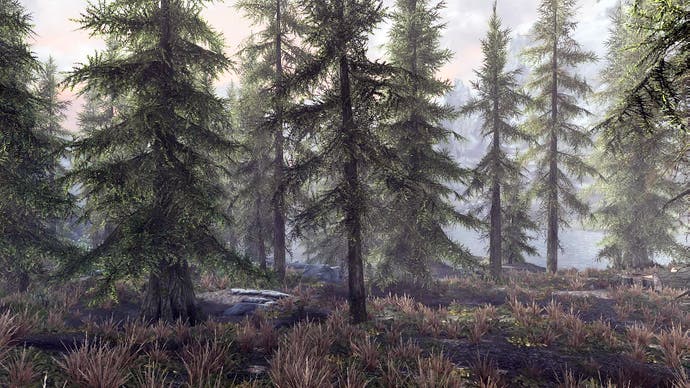
Further to their importance, pines specifically have an emblematic, wintry importance: they are seen as symbols of longevity, steadfastness and survival in adversity because of the hostile conditions they can survive, and thrive, in. These qualities echo throughout Skyrim and our experiences there: inhabitants withstanding a harsh environment; the desire for longevity in a vast and hazardous land; and the need to grow stronger in the face adversity.
Evergreen trees are also known to represent life and death. David Caspar Friedrich's Winter Landscape with Church painting aided this by imbuing the trees with a spiritual symbology: in the foreground, and as the focal point of a man's prayer, they reach upward to the winter sun, and mirror the architecture of a church that looms out of the mist in the background. It highlighted the pine trees ability to represent life in trying conditions, but also their ability to mimic and mirror architecture, sharing in the meaning of the building (a gothic, Christian church in the painting's case). This mimicking and reinforcing of architecture can easily be seen in Skyrim; their jagged branches evocative of archways and buttresses; and their peaks representing architectural pinnacles - all exposed and highlighted by winter's effect on the land, creating a layered, deep and wondrous landscape.

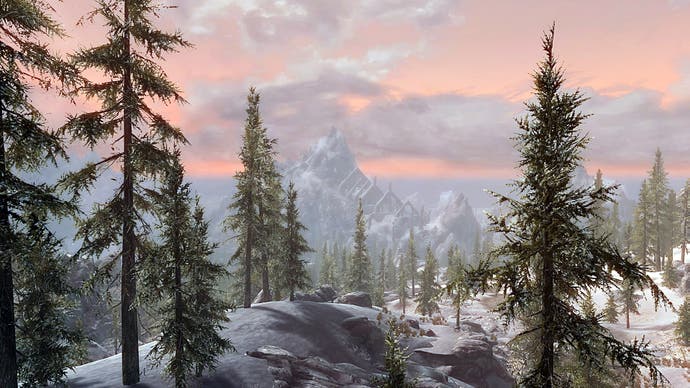
The neighbouring softscapes that surround the trees and forests complement them accentuate the breadth of winter's aesthetic, and effects on the landscape. Departing from the snowy stereotype, the alpine meadow-esque spaces in Skyrim bring their own character. Here, bare and frozen soil gives way only to the hardiest of plant species, such as towering, white-barked birch trees (along with the ever-present pines), tussock grasses, and bistorts, all of which hint at active life in the face of adversity. However, brown ferns, the skeletons of shrubs, and the nearby snowy mountains and tracks ensure that winter's true influence is never far away. With exposed rocky outcrops and almost-magical, steaming pools of water or springs, these pockets of 'different' landscapes show the breadth of Skyrim's representation of winter and its ability to create a tapestry of beautiful and magical, yet relatable, winter spaces.
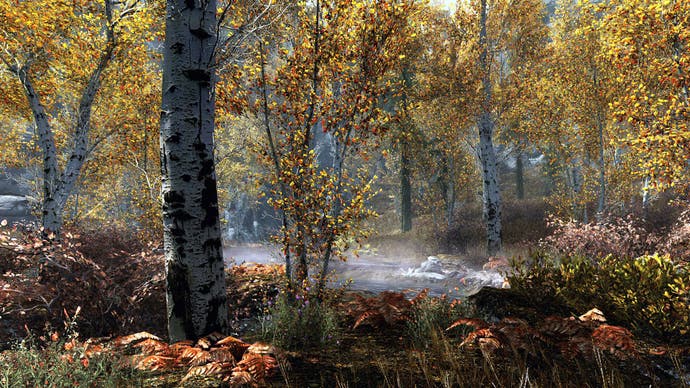
The magic underpinning of all of Inquisition's tremendously diverse landscapes makes for brilliantly majestic and intriguing environments, perhaps none more so that Emprise du Lion. Here, jagged protrusions of lyrium crystals thrust violently upward, contrasting beautifully with the snowy landscape and provide an immediately apparent, and overt, connection between magic and land, in a fabulous winter-affected setting. While some landscapes are at their most powerful when they are most relatable, the inclusion of magic and ancient Elven influences in such an obvious way, and not being closely tied to real-world inspirations, heightens a landscape's mystery and majesty.
The most majestic facets of Emprise du Lion's winter landscape impact it on a large scale and by implementing a crossover between the area's natural and designed architecture. There is a dominance of the natural geography by the architecture of the landscape: cliffsides, mountains, deep ravines, stacks of rocks and geological outcrops. These guide the structure of the landscape powerfully but are offset nicely by the land's contours, trees and plants. The sheer beauty of the natural geography brings its own enchantment, enhancing the connection between magic and land. The finishes of snow coverage, falling snowflakes, frozen water and shiny, icy lacquers ensure that the natural elements are intrinsically linked to the wintry environment, giving a nod to winter's own magic.
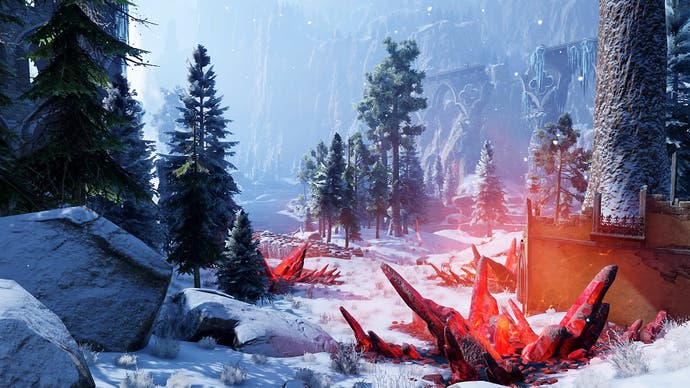
In relation to this, looking as though the elements of it were carved out of the mountains and harsh rockfaces, the relics of the ancient elven population, in the form of their architecture is also massive and dominant. It mirrors the wintry, natural geography in its scale and majesty, yet is clearly, and successfully, designed in its own right. The now-derelict archways connect the designed and the natural through form and structure, mirroring the enormity of the mountains, taking on the character of wind- or water-carved caves, while also picking up on the form of the far-reaching evergreen trees. This connection and mirroring occurs throughout the landscape, with winter acting as a beautiful, natural leveller. This matches perfectly with the real-world design principle of ensuring relevance, balance and interest throughout the year: a garden or landscape design is only truly successful, and special, when it factors in all seasons and ensures that elements work together, pick up on each other and reveal interest and beauty regardless of the seasonal aesthetic.
Winter's effects on the land are that of a great equaliser in Emprise du Lion: it's harsh, damaging weather eroding the natural architecture and the ancient elven ruins; its hostile temperatures and conditions reducing life to a minimum; the wind whistling through trees and architecture alike; and the mysterious, hauntingly empty and abandoned feel to both the elven and natural architecture evoking a sense of emptiness and dormancy that the winter landscape exacerbates. With the winter aesthetic draped over them, means that the two architectures are almost merged into one, but certainly mirror and reflect each other's character across Emprise du Lion.

Such reflections between large-scale landscape elements increases the power of the landscape by contributing to the composition of impactful views and vistas. For example, the frozen lake is a small mechanic of a wintry landscape in itself, but, framed by the mountains and elven architecture, the lake in Emprise du Lion almost doubles the impact sky through reflection and mirroring. Even if it's not crystal clear, due to the importance of the sky in Inquisition as the location of the fade rift, the reflection provides an environmental, attention-directing nod to a crucial part of the game's story. Beyond that, the land's architecture, comprising of both natural and designed, provides vast views that are equalised yet enhanced by winter. Emprise du Lion becomes an environment where even the elven influence feels relatable, as winter exerts its influence, merging them with the natural landscape, resulting in the creation of a mysterious yet impactful place.
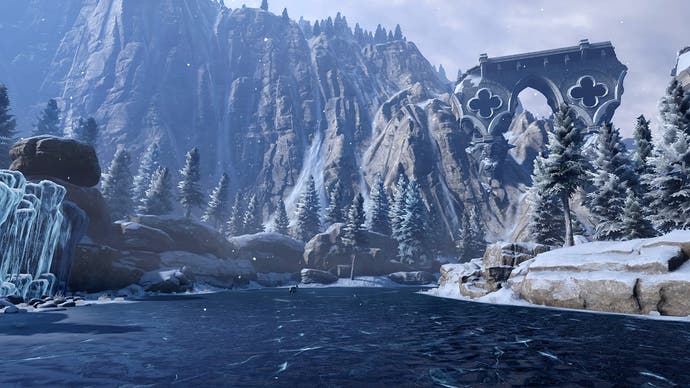
In its own league of landscape and vistas, The Witcher 3's use of winter is, unsurprisingly, an incredibly effective one. It deploys the effects and feelings of the season beautifully, blending components of winter environments seamlessly together to achieve further astounding feats of virtual landscape design and representation. The mix of genuine representation and attention to detail both at the large and small scale is the success behind The Witcher 3's landscapes, and the winter environment prevalent throughout the isles of Skellige is no different.
Here, it is the execution of the larger landscape elements and their winter portrayal which begin to paint the (breath-taking) picture. The most dominant natural influence in Skellige is the geology - without this, wintry landscapes and their magic would be greatly lessened. In Skellige, the nuances of geological formations are both accurate but also influential. On islands thrust out of the sea, the geological variety sets the scene: if mountains look jagged and sharp, they are geologically young, as the formations have not been subject to the effects of weather, (particularly the harshness of the Skellige winters); if the mountains and hills are smoother, sometimes wooded or covered in plants, the greater the age of the land, erosion taking its toll and plants having had time to establish themselves. This gives each vista or view a distinct sense of geological and natural age and character. It also enables the revealing, equalising effect on geology that winter has, and the toll it takes on even the largest landscape elements.

Winter's ability to alter and give character the landscape is also visible in other areas. In a distinctly beautiful place between Fayrlund and Fyresdal there is a large plain with multiple shallow, steaming streams and colourful winter plants. This feels like a landscape formed by a glacial course carving its way through the mountains. Winter then finishes the scene with its typical aesthetic covering the hillsides and mountaintops while presenting plants that have adapted to winter to thrive, offering colour, form, texture and scale. Spaces such as this show the clear effect of a deep winter and the sheer power it has, leaving behind forever-changed landscape imbued with environmental age and character, but one that is distinctly beautiful in its own right.
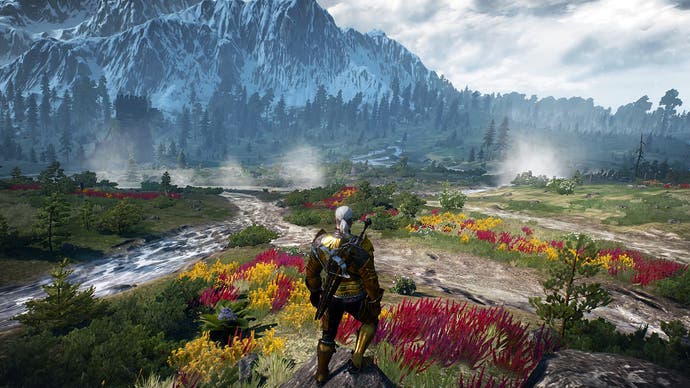
This theme is similar in the foothills. As the slopes are eroded away, made smoother and gentler, trees and plants take root - often in the form of evergreen forests. They establish themselves and spread as far as the land and conditions will allow. What results are distinct tree and vegetation lines that only a few anomalies stray from. It seems that when one natural effect slows down (the weather eroding the mountains), another steps in and leaves its mark. By executing the gradients of the natural architecture and environment accurately, and demonstrating the resulting plant-based takeover, the winter landscape is somewhat softened, and the views and vistas that set Skellige apart are framed, shaped and finished.

The forests that establish themselves in the foothills comprise of evergreen trees that still harbour and exude that symbology of survival, toughness and longevity. Yet, there are other elements of symbology and importance that come from The Witcher 3's medieval-European inspiration. Pine forests were often the setting for fairy tales and legends, so represented mystery, the unknown and darkness. But, they also had an almost sacred status in Celtic places such as Scotland - a place that Skellige clearly evokes - where they were burned to commemorate the changing of the seasons, and their needles burned to purify dwellings and ritual areas. Given the Celtic qualities and 'druids' of Skellige, the clear connection between the culture of the islands and the pine trees (having a monopoly on the land) is undeniable.
The trees and forests themselves are tremendously accurate, too. They follow aforementioned tree lines on hillsides, include deciduous trees like Russian oaks alongside the evergreens, have a sparser arrangement near tracks and paths, and even show some trees that have died clearly succumbing to the harsh winters - a powerful reminder of the cost on the landscape that the season can have. Across the fields and plains, the horticultural accuracy is spectacularly good, and it is the smaller shrubs, plants and groundcovers that give Skellige's winter landscape horticultural impact. Like the final adjustment of the last decoration on a Christmas tree, they help to finish the power, attraction and allure of the winter landscape. The beautiful but hardy grasses that wave pleasingly in the wind, covering the rolling hillsides remain resolute in the tough winter conditions, while more ornamental and some colourful ornamental plants such as bistorts, ferns and what looks like Japanese blood grass burst through providing gorgeous pops of colour. Across all of Skellige, it is clear that the horticultural diversity and beauty make for a staggering landscape, but on that is constantly influenced and guided by winter.
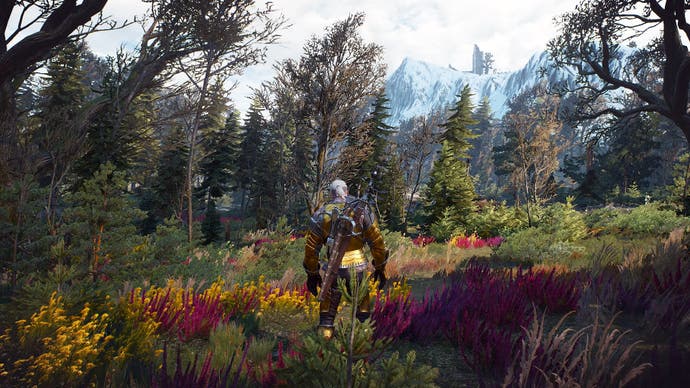
Wrapped up in environments so expansive and wondrous, these winter landscapes are true treats of virtual environments. The way that these landscapes depict, represent and evoke winter, the effect it has on the lands, and the resulting atmospheres so successfully, down to the sound of the wind, means they comfortably eclipse generic landscapes that have received a snowy makeover. Using the season to show change and balance between natural and designed architecture, to create breath-taking vistas with winter-affected landscape accuracy, and to use symbology effectively, result in places that may only offer the bones of the landscape to the eye, yet are actually full of meaning. They are genuine and meaningful representations of winter, not landscapes in seasonal denial.
That the impact of the seasons on landscapes has permeated into game design, providing us with immense, beautiful scenery and important, world-finishing, narrative-helping environments, makes them all the more immersive and memorable - demonstrating the importance now afforded to the art of placemaking in games. For those of us that often miss out on a real winter landscape, these ones provide valuable, virtual alternatives.
